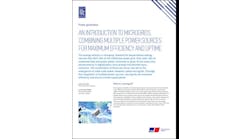Calculating Microgrid Return on Investment (ROI): What’s Electric Reliability Worth?
Power outages carry a cost. But exactly how much? Not knowing makes it difficult to calculate microgrid return on investment (ROI), as we explain in “How Microgrids Can Achieve Maximum Return on Investment (ROI): The Role of the Advanced Microgrid Controller.” Below is an excerpt.
Return on investment, or ROI, is a common financial metric used to show the return an investment receives relative to its cost. ROI takes on various forms depending on the industry. For some energy projects, including microgrids, the analysis tends to center on payback—the number of years it takes for the customer to pay back the initial investment and begin seeing a positive cash flow.
At first glance, the idea of establishing ROI for a microgrid seems simple: What did the microgrid cost and what did the customer save on energy bills? How quickly will the savings pay back the investment?
But savings on energy bills alone does not fully value the microgrid. As we pointed out in the previous chapter, microgrids provide value in several ways not readily reflected in bill savings.
Energy reliability—a microgrid’s ability to keep power flowing when the central grid fails—is one of the most important, and most difficult, values to prove. Reliability is often a main reason why customers choose to install microgrids. So the question becomes: What will a power outage cost your operation? The answer varies by customer.
Mice and microgrid return on investment
For example, a research lab can lose years of research, millions of dollars of work, from a power outage. At the University of Texas, energy reliability is valued highly because 80 percent of the campus space is dedicated to research worth about $500 million.
“If a professor loses a transgenic mouse with 20 years of research built into it, that’s a nightmare. That’s what keeps me up at night,” says Juan Ontiveros, the university’s executive director of Utilities and Energy Management, told MicrogridKnowledge.com.
Not surprisingly, the university has invested in one of North America’s largest microgrids, a facility with 35-MW (62-MW peak) electric capacity and 1.2 million lb/hr of steam generation (300k peak).
Data centers, supermarkets and certain industrial facilities face similar steep losses from power outages. The military also highly values reliability and has been an early adopter of microgrids. Often the military centers discussion of reliability around energy security, the ability to retain enough power supply to support mission critical responsibilities.
The National Renewable Energy Laboratory (NREL) analyzed the value of electrical energy security at Fort Belvoir military base and pegged it at $2.2 million to $3.9 million annually. NREL’s range reflected the mission of the respective uses within the base and recent performance metrics of each utility. http://www.navigantresearch.com/blog/building-the-business-case-for-commercial-microgridsNREL looked at three approaches to value energy security:
▶▶A macro approach that divided total annual energy consumption into gross domestic product to come up with a $/kWh outage cost
▶▶A microscopic approach based on a customer survey that looked at duration of outages, the situation under which it occurred and the customer activity
▶▶An analytical method that considered expected energy not supplied and cost
In deriving the energy security value for Fort Belvoir, NREL employed the microscopic approach, according to NREL researcher Julieta Giraldez.
NREL found that an advanced microgrid—one that continuously optimized its assets—offered greater reliability and greater economic value. While an advanced microgrid may cost more to build than a simple microgrid, the advanced microgrid can provide many more functionalities.
The mystery value
Despite the work of NREL and others, the industry continues to debate the best way to value reliability. As Peter Asmus of Navigant Research says:
“The primary metric that remains a mystery is the value of reliability. Quantifying the benefits of reliability is both art and science. At this point in time, there are no widely recognized financial metrics to monetize the value of energy security and reliability, the key distinguishing feature of a microgrid network.”
Microgrid developers have been attempting to mold common energy financing models to microgrids. These include:
▶▶The power purchase agreement (PPA), frequently used by independent power generators, solar companies and others that offer energy supply
▶▶The energy savings performance contract (ESPC), a model common to the energy efficiency projects that focuses on sharing cost savings between the contractor and customer
The problem with both of these models is that a microgrid is neither a generator nor an energy efficiency project, but a combination of both —with reliability and other benefits added. Establishing ROI for a microgrid requires understanding the value of reliability, along with the intelligence and abilities of the microgrid controller, which helps create the microgrid’s value streams. Until the industry can establish these values, it will be difficult to determine the most effective financing model.
Learn more by reading “How Microgrids Can Achieve Maximum Return on Investment (ROI): The Role of the Advanced Microgrid Controller,” made available for free download courtesy of Siemens.






